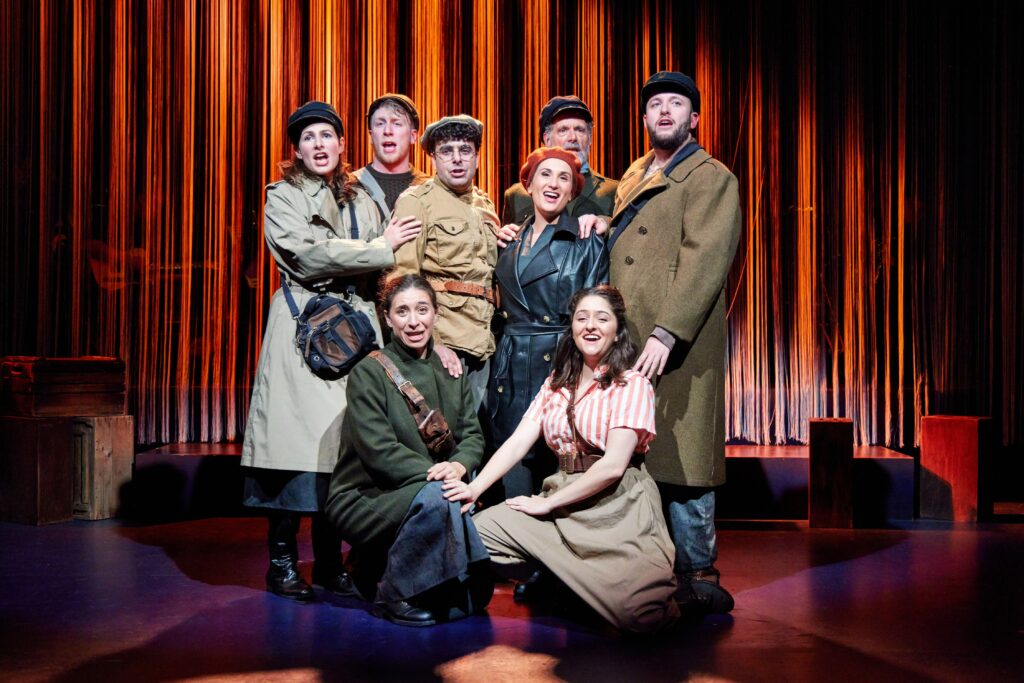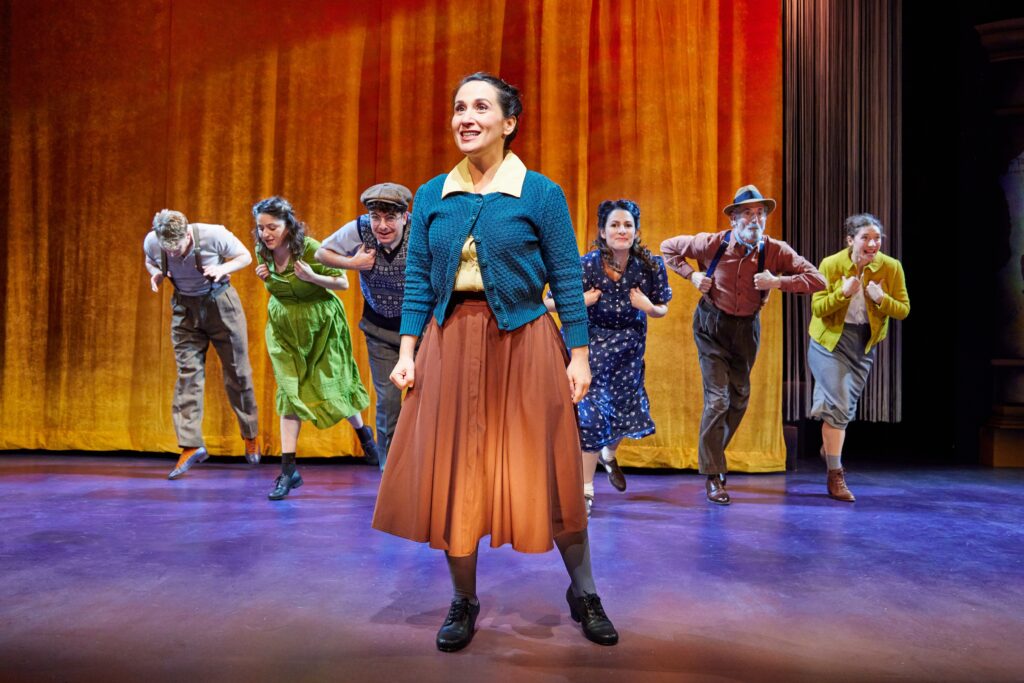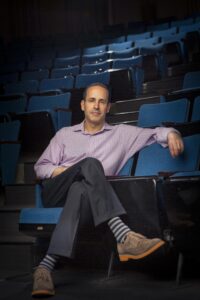Tsvishn Falndike Vent: An Interview With Avram Mlotek, Zalmen Mlotek, and Motl Didner

Last November, the National Yiddish Theatre Folksbiene opened its final production of 2023, a musical revue called Amid Falling Walls (Tsvishn Falndike Vent): Unveiling Resilience and Hope During the Holocaust. The production was curated and written by Avram Mlotek, with music curated and arranged by Zalmen Mlotek, and directed by Motl Didner. The Folksbiene’s website explains that the production:
[…] delves into the songs created and performed in ghettos, cabarets, partisan encampments, concentration camps, and clandestine theaters.
The musical weaves in first-hand testimony of Holocaust survivors through their poetry and music, preserving their authentic voices. Despite the tragic loss of many of the young creators, their songs come alive in this unprecedented Off-Broadway theatrical production. It stands as a tribute, narrating the true story of resistance and hope through the words and melodies of those who endured those harrowing times.
A substantial portion of the material we witness today is due to the tireless efforts of Shmerke Kaczerginski, a poet, partisan, and a member of the famed YIVO Paper Brigade. He dedicated years of his life post-war to collect the songs of those who lived through the horrors of the Holocaust.
The phrase “Tsvishn Falndike Vent” is a fragment of the “Partisan Hymn,” a poignant song written in 1943 in the Vilna Ghetto. Its powerful lyrics quickly spread through the forests, ghettos, and camps, becoming a rallying cry for many.
Many of the songs featured in Amid Falling Walls (Tsvishn Falndike Vent) were carefully curated by Yosl Mlotek, who served as the education director at the Jewish cultural organization, The Workers Circle, and Chana Mlotek, an ethnomusicologist and folklorist who served as the longstanding music archivist for The YIVO Institute for Jewish Research.
The three architects of the production kindly agreed to participate in an interview via correspondence with DYTP co-founders Joel Berkowitz and Debra Caplan. The interview has been lightly edited for style and consistency.

DYTP: Motl, you told the Forward that this production was inspired by the album Ghetto Tango (2000), a compilation performed by Zalmen Mlotek and the late Adrienne Cooper. Tell our readers a bit about that work and why it’s so important to you.
Motl: I first came across Ghetto Tango in 2003, early into my Yiddish studies, when I was first volunteering at the Folksbiene and other Yiddish organizations. I was given a stack of CDs as a gift for helping out at a gala and this was among the offerings. I would listen to the album nearly every day during my commute. It had captured my imagination as much of the material had come from cabarets and theatres performed as the Holocaust was occurring. The music often sounded like conventional musical theater songs of the era. But the lyrics were a stark reaction; sometimes a profound expression of grief, sometimes quite hopeful, sometimes a protest against the inequities of life in the ghettos under the Judenrat, sometimes rage at the mass murder of the Jewish people and a call for revenge.
The album contained songs that painted an immersive picture of what it was to be in that place and time in a way that could never be explained in a history lesson.
As a theatre director, I would dream about what it would be like to stage these songs. Twenty years later … here we are.
DYTP: Zalmen, what are the most important memories you have of working on Ghetto Tango? And what does that project mean to you as you look back on it now?
Zalmen: What was exciting about working on this material with Adrienne, was our discoveries in the Kaczerginski collection, Lider fun di getos un lagern [Songs From the Ghettos and Concentration Camps]—where we would make new discoveries all the time—that would excite us. I do want to add though, while Ghetto Tango was definitely an inspiration for this piece, there were two other recordings that I worked on that also influenced the eventual musical score of Tsvishn Falndiike Vent.
One was a concert I did in Warsaw with Shura Lipovsky and Jeff Warschauer, which we curated to celebrate the 75th anniversary of the Warsaw Ghetto Uprising. It led to a recording called Heroes and Poets. Another CD was Remember the Children, which grew out of a concert curated by Bret Werb for the US Holocaust Memorial Museum, where I performed. These were in addition to my lifelong knowledge of these songs—firsthand from survivors, and then teaching them in summer camps and Yiddish schools for many years as well.
As far as my work with Adrienne—it was the excitement of finding this new material that we hadn’t heard before—we looked through the songs Kaczerginski collected and found songs like “Mues” and “Moyshe Halt Zikh,” and read in Gila Flam’s work about street performers like Yankele Hershkowitz. In her book Singing for Survival, Gila Flam writes that “Most entertainers, while able to draw a crowd, could not collect enough money on which to survive. Thus, one by one, they vanished until but a single performer, a ‘voice of the ghetto,’ remained: Yankele Hershkowitz. A short, heavy man, who stood on a stool to perform, and who was sometimes accompanied by the Viennese violinist Karl Rosentsweig, Hershkowitz composed songs that commented on the ongoing events with satire and humor.”1
Curating these songs we chose for Ghetto Tango and working on arrangements with Adrienne was an exciting collaboration for us. She, with her classical voice training, would endow the music with her musicality, and when I knew of the provenance of some of these songs, written for the cabarets in Warsaw, Łódź, and Vilna, I imagined what that sound might have been. We collaborated with Frank London and Michael Winograd, who between them did all the orchestrations, thus taking what I had originally performed for piano to a broader palette, with arrangements that we felt best suited each song.
DYTP: Avram, your father mentioned the poet-partisan Shmerke Kaczerginski (1908-1954), who figures significantly in Tsvishn Falndike Vent. Kaczerginski was a man of many parts. What makes him particularly important to you?
Avram: Kaczerginski was mission driven. Whether it was Yung Vilne, the Paper Brigade, the FPO, his wartime collection and writings—his passion seemed to infuse his work and many projects and life commitments. For this project, we listened to recordings of his talks which were more like orations with this infectious, ferocious-like quality as he spoke of the value of Jewish life and resistance during the war. I admire his personal story, his ambition, and of course his art.
DYTP: Zalmen and Avram, you’re directly related to two other figures who don’t appear in this piece, but whose influence looms large over it: your parents and grandparents respectively, Chana and Yosl Mlotek, z”l. What in particular comes to mind when you think about their relationship with the music and texts presented in Tsvishn Falndike Vent?
Zalmen My mother Chana Mlotek and my father Yosl Mlotek—who published several Yiddish song anthologies, including the first transliterated and translated collection of Holocaust songs Mir Zaynen Do (We Are Here) a collection she worked on with my aunt, her sister, Malke Gottlieb, with singable English translations by Rosalind Perry—fell in love through Yiddish song. My father, a refugee from Warsaw, having lived in Shanghai for the entirety of the war, and my American-born mother, born to immigrants from Russia, in the early immigration to the US, shared a love for Yiddish song and theater and a passion for Yiddish folk songs.
In their home in the Amalgamated Cooperative Housing in the Bronx, they would have late-night parties with my father’s friends from Warsaw who survived the war, along with the leading Yiddish performers of the day like Mina Bern, Ben Bonus, Leon Liebgold, Lili Lilliana, and many others. In fact, it was hearing and seeing Liebgold and Liliana, both well-known stars in Yiddish cinema, and Yiddish theatre. They would perform the song “Ikh ganve in der nakht,” [I Steal at Night] as my mother describes the song in one of the six collections of Yiddish songs she published with my father (from yiddishsongs.org)2—written by Moishe Broderson (1890-1956), music by David Beigelman (1887-1944), for the Ararat Theatre of pre-war Warsaw. The song, which incorporated the argot of the underworld, was a popular repertory piece of the singer actors Leon Liebgold and Lily Liliana. During the Holocaust, the melody was used for two songs in the Lodz ghetto, collected by Gila Flam, “Amerike hot derklert” (America Explained).
Avram: My Bubby’s3 piano usually lives in the Folksbiene office though it made its way to our pit as my father plays from it every night of our run. I love that it is being put to use and has been incorporated in our work since her presence obviously looms large for all us. In addition to a mother and grandmother and great-grandmother, she was a world-renowned expert on Yiddish song including publishing the first English translated collection of Yiddish Holocaust songs. I can’t count the number of questions I wish I could have asked her over the course of our research and writing. As for my zeyde4, an excerpt of his sister Sore Rosenfeld’s poem “Mayn mile gas” (My Mila Street) appears in our libretto. Sore, like Zeyde, was a Yiddish cultural activist but based in Montreal. For me, my grandparents’ imprint is everywhere in this work.

DYTP: You’ve previously worked with many of the actors in this production, including Steven Skybell, Rachel Zatloff and Mikhl Yashinsky, in other recent Folksbiene productions, including Fiddler on the Roof in Yiddish. What has it been like working with these performers again? I’m particularly interested to hear about your experience working with non-Yiddish speaking performers on a second (or third or fourth!) Yiddish show.
Motl: Steven Skybell, Rachel Zatcoff, Mikhl Yashinsky, Abby Goldfarb, and Yael Chanukov are all Fiddler alumni. Rachel first performed with NYTF in Di Goldene Kale (The Golden Bride) in 2015. Daniella Rabbani-Sirkin has performed with NYTF in several productions going back to 2007, including ongoing concerts of the songs from Ghetto Tango which Daniella and Avram have performed together with Zalmen over the last 10 years. Dani Apple and Mikhl Yashinsky appeared previously with NYTF in Avrom Goldfaden’s Di Kishefmakherin (The Sorceress).
Jacob Ben-Shmuel, Eli Mayer, and John Reed are all making their debut on the Yiddish stage, although it should be noted that John Reed had been cast in the Yiddish Fiddler that was set to be produced in Sydney and Melbourne, Australia in the summer and fall of 2020.
Mikhl is the only one completely fluent in Yiddish. Daniella has studied and been performing in Yiddish for many years. Steven began studying Yiddish during the pandemic and has become quite conversant. He has also learned something like 150 Yiddish songs.
For the new cast members, they demonstrated an excellent ability to learn the text and to sound natural when singing and reciting during the auditions.
For the non-Yiddish speaking cast members, we have established a process which includes preparing recordings and working together in coaching sessions before rehearsals begin.
Zalmen: In choosing who we wanted to sing these songs, and interpret them, we had some ideas from people that he had worked with before. Daniella Rabbani-Sirkin has performed much of this material in a concert version of Ghetto Tango. Steven Skybell, who after playing Tevye in our Yiddish Fiddler, worked with me every week during the height of the COVID pandemic, learning a new Yiddish song on Zoom, looks at every song as a new piece of literature that he, the trained Shakespearian actor, begins his study of the song with the text. In many cases that re-introduced me to songs that I have known all my life,and Steven’s interpretations brought a whole new world related to these songs to life.
Rachel Zatcoff, Abby Goldfarb, and Yael Chanukov were all a part of the Yiddish Fiddler—and all three have a unique relationship to this music, each one singing it with their own passion and truth. Mikhl Yashinsky was also in our Yiddish Fiddler and as the only cast member who spoke Yiddish fluently and is a Yiddish teacher was very helpful. Dani Apple was in one of our earlier productions and also has the experience of being in our production of Di Kishefmakherin. The three other men, Jacob Ben Shmuel, Eli Mayer, and John Reed, three wonderfully talented non-Yiddish speakers, masterfully have learned this music and the language we discovered through our audition process, which consisted of seeing over 350 actor/singers, for the eight actors and two swings we needed.

DYTP: How did you choose which songs to include in the show? Were you looking for specific connections between them, or more to give audience members a sense of the scope of this material?
Motl: The selection of songs has evolved over time. In addition to several drafts of the libretto, going back about two years, prepared by Avram, we had two rounds of workshops. The first, in the winter of 2023 was just an exploration of the songs with musicians and singers from the Yiddish world, some of whom already knew a lot of these songs.
It was sort of like a few weeks of jam sessions to see the different ways that we could present these songs, find songs which fit together into segments, and clarify the narratives by exploring them as solos, duets, group songs, etc. During that time, Zalmen and Avram discovered songs within the Kaczerginski collection that we were previously unfamiliar with. Some of it was quite surprising, like “Peshe Fun Reshe” (Peshe From Reshe) which has a musical quotation from Madame Butterfly, the cryptic “Korene Yorn un Vey Tsu Di Teg” (Years of Corn and Years of Woe), which sounds very much like it could be a Rogers and Hammerstein creation, and “Mir Lebn Eybik” (We Live Forever), which sounds very much like the closing number to a musical. And it was little wonder that they had all come from the Vilna Ghetto Theatre.
The libretto was then refined for a staged reading in the summer of 2023 which included much but not all of the same material, now accompanied by texts found in diaries and other accounts which helped to provide context. The show was now in the hands of actors who really brought these stories to life. We were able to test the material in front of a small audience.
Further changes were made to the libretto and the songs selected for the final production. Some further changes were made in rehearsal and even during previews.
There are many songs which we were not able to include, not because they are not worthy, but simply because the themes were already so well represented by other selections or because they did not fit into the narrative. Enough to make even more shows about what was being written and performed in these years.
Zalmen: In re-examining Kaczerginski, and going through every one of the 100 or so songs where a melody line existed, I imagined what some of these songs might sound like, if they were performed in the way they were intended, like finding “Korene Yorn un Vey Tsu di Teg” ( a satirical twist on the Yiddish phrase “Korene yorn un veytsene teg” – days of corn and wheat).

DYTP: In a way, Tsvishn Falndike Vent is like a jukebox musical—perhaps the first Yiddish jukebox musical, or at least, the first one in a long time. Writing a book for a show built around pre-existing music poses some specific challenges. Avram, can you tell us about your book writing process?
Avram: I think all of my father’s previous original musicals (Those Were The Days, On Second Avenue, The Golden Land) were “Yiddish jukebox musicals” to a degree in that they were productions centered around themes and the music was there to evoke that. When we began to look at my father’s other albums of Yiddish wartime music and returned to Kaczerginski’s collection, Tsvishn Falndike Vent‘s scope quickly grew. We saw themes emerge between the types of songs and environments we visited and wished to portray. The songs were the stories, the testimonies and as opposed to wanting to create false narratives, we relied on the songs to tell the story of the moment. Our book, like everything else in this production, was in service of the songs and the feeling we hoped to explore.
DYTP: In some ways we’re living in a different world now from when this show was conceived—we’re thinking in particular of events in Israel and Gaza since the Hamas attack on October 7th. How have those events affected your and others’ feelings about what this show means right now?
Motl: Rehearsals began just one week following the October 7th attack by Hamas. But we have been seeing the resurgence of antisemitism for many years. The sad fact is that events like the Tree of Life Synagogue shooting as well as other attacks on synagogues and JCCs in San Diego, Kansas City, Seattle, Colleyville, Texas and violence committed or threatened against Jews on the streets of New York City and all around the world, would have been enough to make Tsvishn Falndike Vent relevant in 2023.
But we all were, and continue to be, affected by the October 7th attack by Hamas. Many of us have relatives in Israel and we fear for their safety and well-being. And of course, this has only amplified acts of Jew-hatred here at home.
Unlike during the Holocaust, Jews in Israel may be in a position of power in this conflict, but nevertheless more than 1,000 civilians, in the course of living out their lives, were killed and many more injured, traumatized, and held captive, simply for being Jews. The ideology of Hamas, as with the Nazis, leaves no place for Jews in this world.
Avram: Showing up for rehearsal days after the most fatal assault against Jews since the Holocaust wasn’t lost on anyone. Suddenly, Leyb Rozental’s words felt all the more urgent and continue to feel so: “Mir lebn eybik, es brent a velt…mir viln lebn un derlebn, shlekhte tsaytn ariberlebn, mir lebn eybik, mir zaynen do! We live eternally, as the world burns…we wish to live and outlive, overcoming horrible times, we live eternally, we are here!”
Zalmen: Teaching this music, these words, in those early days right after Oct 7th, was very difficult but inspiring with each of us in the rehearsal room affected by the news to our cores- and realizing how a propos songs like “Zog nit keynmol az du geyst dem letstn veg” (Never Say You’re Walking the Final Road) or “Mir lebn eybik” are for us today, and how powerful it was to sing them at this very time in history.
- Gila Flam, Singing for Survival: Songs of the Lodz Ghetto, 1940-45 (Urbana: University of Illinois Press, 1992), 24. ↩︎
- The entire collection – 6 volumes of songs are available on the website yiddishsongs.org, where all the songs are free to download. ↩︎
- A variation on the Yiddish word bobe (grandmother). ↩︎
- Yiddish for “grandfather.” ↩︎
Article Author(s)

Joel Berkowitz
Joel is Professor of English and Director of the Sam and Helen Stahl Center for Jewish Studies at the University of Wisconsin-Milwaukee.